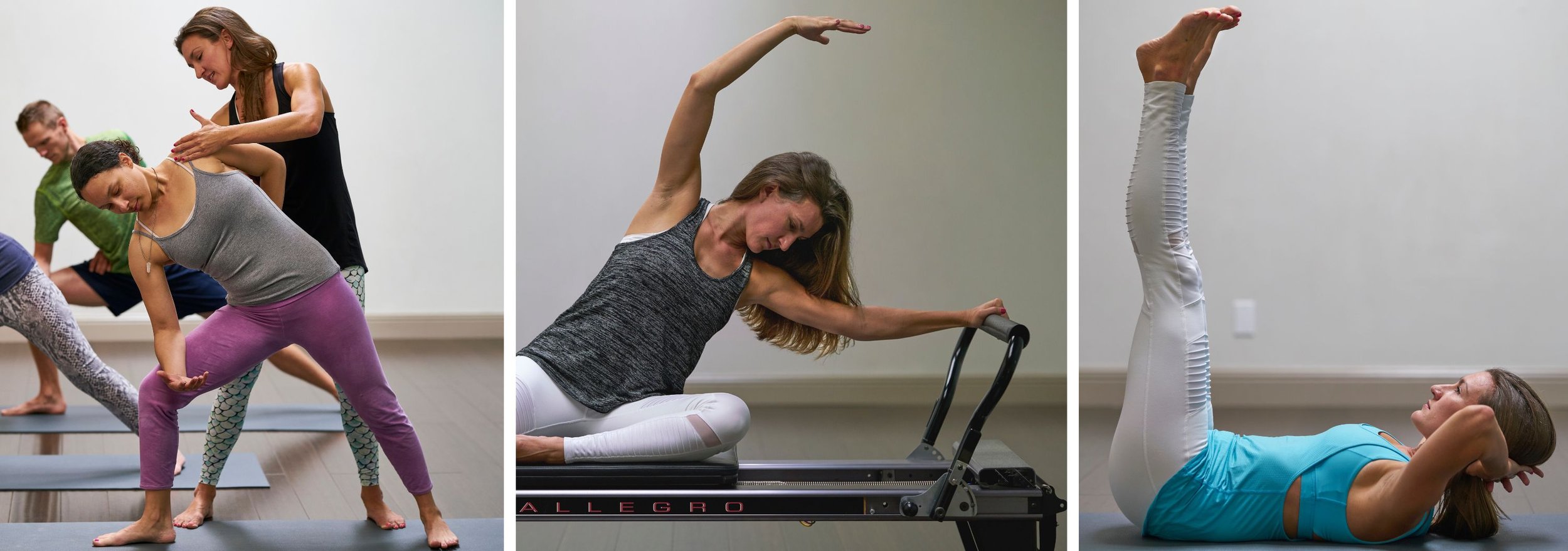I ❤️ Pilates. I ❤️ yoga.
They’ve both completely changed my life.
Through these practices, I’ve:
Managed and healed chronic pain, stiffness and joint instability in my neck and low back
Learned to breathe (this may not sound like much but learning to breathe in a way that eases - rather than creates - tension, that soothes an over-stressed mind and makes your workout not only feel better but makes it more effective as well is pretty magical)
Grown an inch (no magic here - that's the power of good posture!)
Realized I wasn't broken (which was how I felt for years due to injuries and a car accident). I'm strong and capable of way more than I believed.
Collected tools for modifying any activity I do so that I don’t re-injure myself
Learned how to pull myself out of my head be present
. . .and oh, yeah, it’s now also my career. Getting to share the tools that have meant so much to my own life still feels like a gift. 🥰🎁
Pilates and yoga have both grown in popularity since I first started practicing them. More and more people are hearing about the benefits and are curious to try them out. . . but they're not quite sure where to start.
A common question I hear is. . .
“Pilates? Yoga? What’s the difference?”
- and -
“Which one would be better for me?”
Let’s start with the similarities.
Pilates and yoga are both mindful movement practices, based on a belief that health & fitness are essential to living a full, happy life.
They both:
Emphasize breathing & coordinating breath with movement
Require little-to-no equipment
Improve balance, coordination, flexibility and functional strength
Offer great low impact exercise for all ages, sizes and ability levels
The differences are less about the movements and more about the intent behind them.
YOGA is. . .
An ancient spiritual practice with the ultimate goal of achieving inner peace.
In the United States, yoga is mostly a physical practice, but the movements (called asanas) are only one component of yoga. Meditation, breath work, and lifestyle are core components of a full practice.
There are several styles of yoga to fit a variety of needs and preferences, from slow, meditative and restorative to very athletic.
Some common styles are:
Hot/Power/Bikram
Vinyasa
Hatha
Yin
Restorative
Yoga is great if you. . .
Need more mobility (Do you often feel stiff or say “I’m not flexible.”)
Possess basic balance & stability
Want to build flexibility, coordination, & mindfulness
Are looking for a way to recover from other activities
Are in need of a mental/emotional outlet
Are on a budget and looking for a low cost exercise option. Yoga is often more widely available and less expensive than Pilates.
Try it for yourself now. . .
PILATES is. . .
A modern practice developed by Joseph Pilates in the early 20th century. Precisely controlled movements build strength, flexibility and joint stability.
Because of this, many people are referred to Pilates to build core strength and ease joint pain - especially back pain.
The ultimate goal is moving through life with ease, joy and the energy to do everything you enjoy.
Joseph Pilates designed his system to be done:
in his studio
with a teacher
on equipment that uses springs to create resistance.
He also developed a collection of exercises that could be done at home, without equipment, between sessions.
There are now options for practicing Pilates on the traditional equipment in a studio or at home - with or without props.
Pilates is great if you. . .
Need more stability (You may be too flexible or have joint or balance issues.)
Have injuries or limiting conditions (equipment based Pilates is best for this)
Are looking for an all-around fitness program - a balance of strength and flexibility
Prefer or need more personal attention (Pilates classes are often limited to 4-6 students).
Are less price sensitive. Pilates tends to cost more than other workouts due to the small class sizes, equipment and comprehensive training required for Pilates instructors.
Try it for yourself now. . .
This class uses a theraband to mimic the resistance of using the Pilates equipment.
They are both comprehensive practices designed to ease tension in both the mind and body.
They both have the power to be life changing.
I hope this helps break down some of the differences and helps you decide which might be best for you.
Essentially. . .
Yoga at its heart is a spiritual practice.
Pilates at its heart is a physical practice.
Tell me. . .
Which do you prefer?
What other questions do you have?



